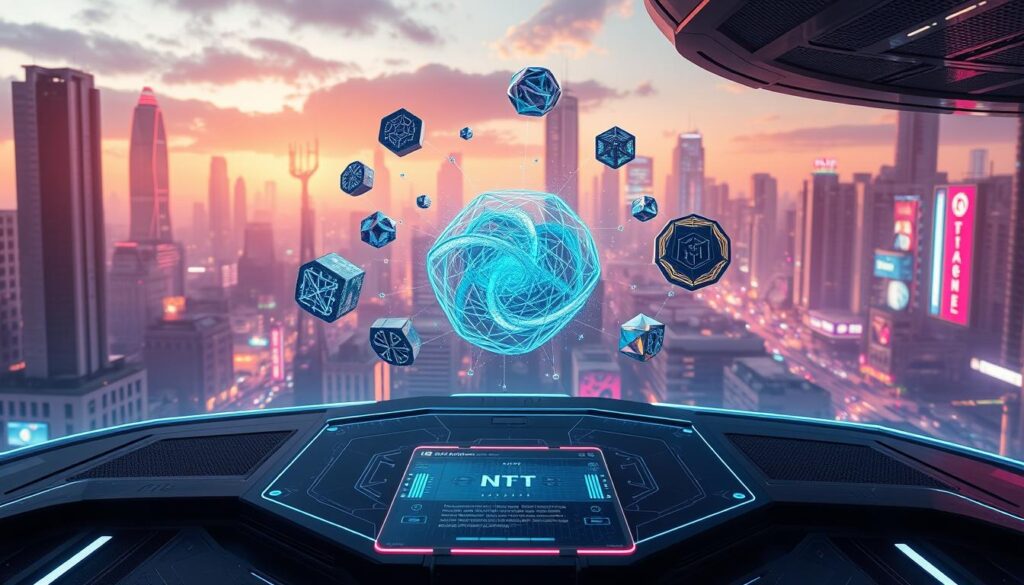The digital asset space is evolving rapidly, and interactive NFTs are leading the charge. Unlike traditional collectibles, these next-gen tokens offer dynamic engagement, blending gaming, art, and blockchain technology. By 2025, experts predict a surge in demand for immersive experiences tied to digital ownership.
The blockchain revolution has transformed how we perceive value. Projects like Decentraland and Bored Ape Yacht Club showcase the potential of virtual worlds and exclusive communities. Now, creators and investors alike are exploring new ways to leverage these assets beyond static images.
With the global market expanding, accessibility and transparency remain key drivers. Whether through staking, gaming royalties, or fractional ownership, opportunities abound. The future of digital collectibles is interactive, and it’s already here.
Key Takeaways
- Interactive NFTs redefine digital ownership with dynamic features.
- The blockchain ensures transparency and security for all transactions.
- Virtual worlds like Decentraland highlight real-world applications.
- New earning models, such as staking, are gaining traction.
- The market is set for exponential growth by 2025.
What Are NFTs and Why Are They Valuable in 2025?
Ownership in the digital world is being redefined by unique blockchain assets. Unlike cryptocurrencies, NFTs (non-fungible tokens) represent one-of-a-kind items, from art to virtual real estate. Each token is verified on the blockchain, ensuring authenticity and permanence.
The Evolution from Static to Interactive NFTs
Early NFTs, like CryptoPunks, were simple digital art with proof of ownership. Today, tokens evolve into interactive experiences. Imagine gaming skins that level up or concert tickets unlocking backstage content.
Projects like NBA Top Shot blend collectibility with utility. Highlights aren’t just clips—they’re tradable assets with built-in royalties. Ethereum’s smart contracts power these features, enabling dynamic behaviors.
Key Drivers of NFT Value in 2025
Four factors will fuel demand:
- Scarcity: Limited editions (e.g., Bored Ape’s 10,000 unique pieces).
- Creator Royalties: Artists earn on resales automatically.
- Metaverse Integration: Virtual land in Decentraland appreciates like physical property.
- Community: Exclusive access to events or DAOs (decentralized organizations).
These elements transform NFTs from collectibles into thriving digital assets with real-world utility.
How to Earn with NFTs 2.0: Interactive Collectibles in 2025
From gaming perks to virtual real estate, the possibilities for profit are expanding rapidly. Interactive features transform static tokens into dynamic revenue streams. Here’s how to capitalize on this shift.
- Creation: Design unique assets with tools like OpenSea’s builder.
- Trading: Flip rare tokens on marketplaces like Rarible.
- Staking: Earn yields through platforms such as NFTX.
- Gaming: Axie Infinity proved play-to-earn models can generate billions.
AI now powers dynamic digital assets, like NFTs that evolve based on user interaction. The Sandbox lets creators embed gameplay mechanics into their tokens, boosting utility.
“Diversification is critical—spread investments across gaming, art, and virtual real estate to mitigate volatility.”
Royalties and fractional ownership open passive income streams. For example, artists earn 10% on resales automatically via smart contracts. Meanwhile, metaverse land parcels appreciate like physical property.
The market rewards innovation. Whether you’re a creator or investor, interactivity is the key to unlocking value in this new era of collectibles.
Platforms like OpenSea simplify transactions, while AI tools streamline content creation. Stay ahead by blending creativity with blockchain’s potential.
Create and Sell Your Own Interactive NFTs
Turning your creativity into digital assets has never been easier. Whether you’re an artist, developer, or hobbyist, the blockchain lets you tokenize unique creations. Interactive features like animations or game integrations add value to your work.
Choosing the Right Digital Medium for Your NFT
Your NFT’s format shapes its appeal. Digital artwork remains popular, but 3D models and VR experiences stand out. Generative AI art tools, like those from Appy Pie, let you design without coding skills.

Consider your audience. Gamers love dynamic assets, while collectors prefer rare *art*. Test formats on small batches before scaling up.
Minting and Listing on Top NFT Marketplaces
Ready to sell NFTs? Start by comparing platforms like OpenSea (2.5% fees) or Foundation for premium art. Decentraland specializes in metaverse assets.
- Wallet Setup: Connect a MetaMask wallet to your chosen platform.
- Gas Fees: Pay in cryptocurrency (Ethereum is common).
- Metadata: Optimize titles, descriptions, and traits for searchability.
“Price competitively—research similar NFTs and set *royalties* (e.g., 10%) for resales.”
Promote your drop via social media collabs or limited editions. Engagement drives demand, turning your passion into profit.
Trade NFTs on Secondary Markets for Profit
Secondary markets offer lucrative opportunities for NFT traders. Platforms like OpenSea and Rarible let you buy and sell digital assets with ease. In 2023, OpenSea’s trading volume hit $20 billion, proving the market’s potential.
Spot undervalued gems during market dips. Tools like NFT Price Floor help track floor prices, while DappRadar analyzes trends. A savvy trader flipped a Bored Ape NFT for 150% profit in six months by timing purchases right.
Stick to trusted platforms like Nifty Gateway to avoid scams. Fake listings and phishing attacks are common—always verify contract addresses. Secure your wallet with two-factor authentication.
“Patience pays off. Buy when others panic, sell when hype peaks.”
Successful trading blends research and timing. Whether you’re flipping rare CryptoPunks or gaming assets, the secondary market rewards strategy. Start small, learn the rhythms, and scale wisely.
Earn Passive Income with NFT Staking
Unlock steady rewards by putting your digital assets to work. Staking lets you earn crypto by locking your tokens in secure smart contracts. Unlike trading, this strategy requires minimal effort while generating consistent income.
Top Platforms for NFT Staking in 2025
Choose the right service to maximize returns. Here are the leading options:
- NFTX: Low-risk vaults for blue-chip collections like Bored Apes.
- Kira Network: High-yield pools (up to 15% APY) for gaming assets.
- Only1: Stake social tokens tied to creator communities.
- Unifty: Offers 8–12% APY on metaverse land parcels.
Splinterlands stands out for in-game assets. Stake cards to earn DEC, their native currency. Decentraland landowners report 7% monthly returns on virtual plots.
“Diversify across platforms to balance risk. Always audit staking contracts before committing funds.”
Risks include smart contract bugs or NFT value drops. Research each platform’s track record. Start small, then scale as you gain confidence.
Invest in High-Potential NFT Collections
Smart investors are turning to digital collectibles for long-term growth. Blue-chip NFTs like Bored Ape Yacht Club surged from 0.08 ETH to 100+ ETH in three years. This proves the value of strategic acquisitions.

Research tools like CoinGecko’s rankings and Discord communities help spot winners. Seasoned collectors prioritize artist reputation, rarity traits, and utility (e.g., metaverse access). Pudgy Penguins and World of Women Galaxy lead 2025’s top picks.
Diversify across niches—gaming, PFPs, and generative art. Dollar-cost averaging during market dips reduces risk. A balanced portfolio blends established projects with emerging stars.
“Focus on assets with strong communities and clear roadmaps. Hype fades, but utility endures.”
Patience pays. The best investment strategy combines due diligence and timing. Whether you’re new or experienced, high-potential NFTs offer a path to digital wealth.
Monetize NFTs Through Gaming and Virtual Worlds
Gaming and virtual worlds are unlocking new ways to profit from digital assets. Play-to-earn models let players earn while enjoying their favorite games. Axie Infinity players made $1,500 monthly at its peak—proof of the potential.
Top Play-to-Earn Games to Watch
These platforms like blend entertainment with income:
| Game | Genre | Earning Potential |
|---|---|---|
| Illuvium | AAA RPG | Sell rare creatures ($200+ each) |
| Star Atlas | Space Exploration | Trade virtual ships (5-10 ETH) |
| Splinterlands | Card Battles | Stake cards for daily rewards |
Guild scholarships let you rent NFTs to players for a profit split. One guild leader shares:
“Leasing Sandbox land to event organizers nets me $800/month passively.”
Future trends include VR integration and cross-game asset use. Imagine a sword earned in Illuvium usable in Star Atlas—this interoperability is coming.
- Sell rare items: Axie Infinity creatures fetch top prices.
- Rent assets: Guilds manage 1,000+ players globally.
- Virtual real estate: Sandbox parcels sold for $4.3M.
Rent Out Your NFTs for Recurring Revenue
Why sell when you can rent? NFT rentals unlock recurring revenue. Leasing your digital assets lets you earn passive income while retaining ownership. Platforms like reNFT and IQ Protocol make it seamless.
Virtual land in Decentraland rents for 0.5–5 ETH monthly. High-demand assets like CryptoPunks fetch 1 ETH per week for metaverse events. Set flexible terms—from days to months—with collateral for security.
Top Rental Platforms Compared
| Platform | Specialization | Fee Structure |
|---|---|---|
| reNFT | Gaming assets | 2% transaction fee |
| IQ Protocol | Metaverse land | 1.5% + gas fees |
| PlayDapp | Event passes | Fixed 3% |
“I leased my Bored Ape for a virtual concert and earned 2 ETH in a week—zero effort.”
Smart contracts automate payments and ownership transfers. Ideal NFTs for renting include:
- Rare gaming skins (Axie Infinity, Illuvium).
- Virtual event tickets with exclusive perks.
- Metaverse real estate for pop-up shops.
Start small. Test the rental market with one asset, then scale. Your digital portfolio could become a cash machine.
Leverage NFT Royalties for Ongoing Income
Smart contracts ensure creators get paid long after the first sale. Unlike traditional art deals, blockchain automates royalties—earning you a cut of every resale. Platforms like EulerBeats pay 3%, while NBA Top Shot enforces 5% fees.

How Royalties Work
Every secondary transaction triggers an automatic payout. The blockchain records ownership and splits profits instantly. No middlemen, no delays—just coded fairness.
Setting Your Royalty Rate
5–10% is the sweet spot. Too high, and resales slow; too low, and you leave money on the table. Marketplaces like Foundation let you lock rates during minting.
“My 2018 NFT collection still earns $50k yearly from resales. Royalties are a game-changer.” — Digital artist
Tax Implications
In the U.S., royalties count as passive income. Report them under Schedule E. Tools like CoinTracker simplify tax reporting for digital assets.
Top Royalty Tracking Tools
| Platform | Feature | Best For |
|---|---|---|
| Etherscan | Real-time contract audits | Developers |
| Nansen | Resale analytics | Investors |
| RoyaltySplit | Multi-payee splits | Collaborative projects |
Stay ahead by auditing your payouts monthly. The right tools turn nfts into lifelong revenue streams.
Explore Fractional Ownership of Premium NFTs
You don’t need deep pockets to own a piece of iconic NFTs anymore. Fractional ownership splits high-value digital assets into affordable shares. Platforms like Fractional.art turn a CryptoPunk into ERC-20 tokens—one sold for $1.5M this way.
Shared ownership lets you pool funds with others. DAOs like PleasrDAO or Otis specialize in group purchases. Imagine owning 5% of a Bored Ape or Beeple’s art without paying the full price.
Benefits vs. Risks
- Accessibility: Buy fractions of blue-chip NFTs for as little as $50.
- Liquidity: Trade shares on secondary markets like Uniswap.
- Governance: Disputes can arise over asset management decisions.
“Fractionalization is the future—it turns million-dollar NFTs into inclusive investments.” — PleasrDAO member
| Platform | Minimum Investment | Specialization |
|---|---|---|
| Fractional.art | $20 | Art & Collectibles |
| Otis | $100 | SEC-compliant shares |
| PleasrDAO | 1 ETH | Iconic NFT acquisitions |
Legal structures vary. U.S. platforms comply with SEC regulations, while others operate globally. Always audit smart contracts before investing.
Invest in Virtual Land and Metaverse Assets
Virtual real estate is reshaping digital ownership, offering lucrative opportunities. Parcels in the metaverse function like physical property—appreciating in value and generating passive income. Sandbox land sales topped $350M in 2023, proving the market’s potential.
Where to Buy Digital Land
Leading platforms like Decentraland and The Sandbox dominate the space. Somnium Space appeals to VR enthusiasts with immersive experiences. Average prices range from 1 ETH for basic plots to 10+ ETH for premium locations.
Monetization strategies include:
- Hosting events: Charge admission for concerts or conferences.
- Renting ad space: Brands pay for virtual billboards.
- Flipping land: One investor turned 1 ETH into 5 ETH in 18 months.
“Developed Sandbox parcels sell 300% faster than empty ones. Building a virtual storefront boosted my ROI.”
Tools like WeMeta provide valuation metrics—comparing location, traffic, and nearby digital assets. AR/VR integration will further spike demand, making early investment strategic.
Start small. Research neighborhood trends, then scale as you grasp the metaverse’s rhythms. Virtual land isn’t just pixels—it’s the foundation of tomorrow’s digital economy.
Risks and Challenges of Earning with NFTs
While digital assets offer exciting opportunities, risks lurk beneath the surface. The market is volatile—BAYC floor prices dropped 60% in 2022. Liquidity crunches can trap your funds when demand dries up.
Scams cost investors $100M+ in 2023. Fake marketplaces mimic trusted platforms like OpenSea. Rug pulls vanish overnight, taking your NFTs and crypto with them.
Legal gray areas abound. Miramax sued Tarantino over Pulp Fiction NFTs, highlighting copyright risks. Always verify ownership rights before minting or buying.
Common Scam Types Compared
| Type | How It Works | Red Flags |
|---|---|---|
| Phishing | Fake emails/wallets steal login details | Misspelled URLs, urgent requests |
| Rug Pulls | Devs abandon project after funding | Anonymous teams, no audits |
| Spoofing | Copies legit NFTs with fake contracts | Unverified collections, low prices |
Ethereum’s energy use sparked environmental debates. Its shift to proof-of-stake (PoS) cut consumption by 99%, easing concerns for eco-conscious buyers.
Protect your investment with these steps:
- Use audited platforms like Coinbase NFT.
- Diversify across art, gaming, and virtual land.
- Avoid over-leveraging—never risk more than 5% of your portfolio.
“Verify contracts on Etherscan before buying. A minute of checking saves months of regret.” — Crypto security expert
Stay informed. The market rewards those who balance ambition with caution.
Why NFTs 2.0 Are a Smart Investment in 2025
Major brands and institutions are betting big on the future of tokenized assets. The interactive NFT market is projected to grow 35% annually through 2030, driven by metaverse adoption and AI-generated content. This isn’t just hype—it’s a fundamental shift in how we own and trade digital assets.
Gaming giants and luxury brands are leading the charge. Gucci’s virtual handbags sold for more than their physical counterparts, while Nike’s .SWOOSH platform bridges fashion and blockchain. Sotheby’s now hosts dedicated NFT auctions, signaling institutional confidence.
Long-term utility sets these tokens apart. Imagine concert tickets that double as collectibles or deeds for virtual land. Some projects even use NFTs for identity verification, unlocking exclusive perks across platforms.
“The next wave isn’t about JPEGs—it’s about interoperability. Your avatar’s outfit could work in games, VR meetings, and beyond.” — Metaverse developer
User-friendly wallets and clearer regulations will drive mainstream adoption. As tools simplify access, the value of well-curated collections will soar. The future of ownership is programmable, and the time to engage is now.
FAQ
What makes interactive NFTs different from traditional digital collectibles?
Unlike static images or videos, interactive NFTs respond to user actions, creating dynamic experiences. These assets evolve, unlock rewards, or integrate with games, making them more engaging.
Which blockchain platforms support NFT staking in 2025?
Ethereum, Solana, and Polygon lead the market with staking options. Platforms like OpenSea and Rarible also offer ways to earn passive income by locking your assets.
Can I sell my interactive NFTs without coding skills?
Yes! There are many user-friendly tools available. Marketplaces like Foundation and SuperRare simplify the process, letting you mint and list digital artwork in minutes.
How do royalties work with NFTs 2.0?
Smart contracts automatically pay creators a percentage (usually 5-10%) every time their asset is resold. This creates ongoing income from secondary market trades.
Conclusion
The future of digital ownership is here, and it’s more dynamic than ever. Whether through staking, gaming, or fractional shares, the NFT market offers endless opportunities. Metaverse land and creative tools like Appy Pie’s generator make entry easy for beginners.
Success starts with research. Diversify your portfolio, manage risks, and start small—even $100 can yield gains. The blockchain ensures transparency, turning pixels into profitable assets.



